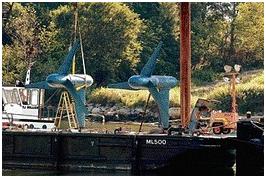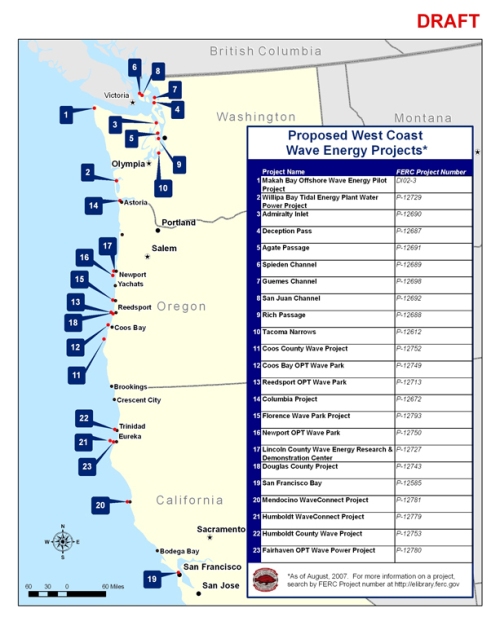MICHELLE MA, Seattle Times, November 17, 2008
What started out as a mad dash to extract energy from the ocean’s waves and tides has slowed to a marathoner’s pace — complete with a few water breaks and sprained ankles along the way.
In the past three years, more than 100 preliminary permits have been issued nationally for wave and tidal energy projects, and nearly 100 more are pending approval. But only one has won a license to operate — a small wave energy development off Washington’s northwest coast.
That project is still awaiting state and federal permits, and its British Columbia-based developer, Finavera Renewables, doesn’t know when the first devices will go in the water. It doesn’t help that a wave power buoy the company was testing off the Oregon coast unexpectedly sank last year.
Tapping the power of waves and tidal currents to generate electricity is promoted as one of many promising alternatives to the fossil fuels that contribute to global warming.
But no one knows exactly how the technologies will behave in the water, whether animals will get hurt, or if costs will pencil out. The permitting process is expensive and cumbersome, and no set method exists for getting projects up and running.
“The industry is really young, and everything is hodgepodged right now,” said Jim Thomson, an oceanographer at the University of Washington’s Applied Physics Lab who is involved in tidal research.
A new report that collected findings from dozens of scientists raises concerns about the impact wave energy developments could have on the ocean and its critters. Wave energy buoys could alter the food chain or disrupt migrations, the report says.
Still, developers, regulators and researchers are moving forward. A 2.25-megawatt project off the coast of Portugal went on line this fall, becoming the world’s first commercial wave energy development in operation. It can supply 1,500 households with electricity.
The first commercial wave energy park in the U.S. could go in off Reedsport, Ore., within the next two years.
Tidal energy has yet to go commercial, but devices have been tested in Ireland and Canada. Turbines have been placed in New York’s East River, and a demonstration project is planned for the Bay of Fundy off Northeastern U.S.
In the Northwest, the Snohomish County Public Utility District (PUD) has narrowed its search for tidal power sites in Puget Sound, although the PUD doesn’t expect to have a test project in the water for another two years.
Race to develop
Dozens of developers have staked claim to plots in the ocean and in waterways that could provide wave and tidal energy. But despite the jostle for space, getting projects off dry land has proved difficult.
Wave power generators use the up-and-down motion of the ocean’s swells to produce electricity. Tidal generators act like underwater windmills, spinning as the tides move in and out.
To get small projects in the water quicker federal regulators recently created a five-year pilot license for tidal and wave developments. That’s meant to help developers gather data they need to launch future projects, said Federal Energy Regulatory Commission spokeswoman Celeste Miller.
Yet even with a more streamlined process, no one has applied for the pilot license, Miller said. Finavera received its license for the 1-megawatt Makah Bay wave project before this option became available.
Given the unknowns in a young industry, it’s not surprising projects are taking longer than some developers would like, said Myke Clark, senior vice president of business development for Finavera.
His company encountered another hurdle when Pacific Gas and Electric’s agreement to buy power from a planned Finavera wave energy project off California was rejected last month by the state’s Public Utilities Commission.
Regulators said the rates were too high and the buoy technology not yet ready.
Clark said the decision wouldn’t affect Finavera’s Makah Bay project.
Research under way
Researchers from the University of Washington and Oregon State University hope that a new national marine renewable energy research center in the Northwest will help answer questions about tidal and wave energy.
A federal grant provides $1.25 million annually for up to five years. The UW will continue research on tidal energy in Puget Sound, while OSU will focus on wave energy.
“The feeling is that a lot of questions being asked now are only questions that can be answered with a responsible pilot [project],” said Brian Polagye, who is pursuing his doctorate in mechanical engineering at the UW.
Locally, researchers want to see where marine life in Puget Sound congregates and to create a standard way to evaluate sites around the country to determine which would be good candidates for tidal energy projects.
Admiralty Inlet, between Whidbey Island and Port Townsend, is the likely spot for the Snohomish County PUD’s small test project set to launch at least two years from now, said Craig Collar, the PUD’s senior manager of energy resource development.
The inlet’s tides are strong, and the area is large enough to accommodate a tidal project without interfering with other activities such as diving and ferry traffic.
Finavera wants to install four wave energy buoys in Makah Bay in the Olympic Coast National Marine Sanctuary to test its technology. Developers also plan to monitor the project for effects on wildlife and shoreline habitat, keeping an eye on federally listed species such as the marbled murrelet, a small bird that dives for food.
Finavera doesn’t intend to continue the project after its five-year license expires. Still, if the company can negotiate a purchasing agreement with the Clallam County Public Utility District, homes in the area could use the wave generated power while the project is in the water, Clark said.
The Makah Nation wants to see what effect the project might have on the environment before deciding whether wave energy is a viable long-term option, said Ryland Bowechop, tourism and economic-development planner for the tribe.
The buoys would sit just offshore from the tribal headquarters in Neah Bay.
“We are always concerned because our livelihood is the ocean,” Bowechop said.
Concerns linger
The environmental effects of wave and tidal energy are largely unknown and require more studies, dozens of scientists concluded after meeting a year ago at OSU’s Hatfield Marine Science Center in Newport, Ore.
The group was concerned that electromagnetic cables on the ocean floor could affect sea life, and that buoys could interfere with whale and fish migration.
Large buoys might actually attract more fish, but the marine ecosystem could be altered if more predators move in. Buoys also could disrupt natural currents and change how sediment is moved. Shorelines might be affected as energy is taken from the waves.
Even if environmental concerns are checked, costs to extract the power remain high. Wave energy costs at least 20 cents per kilowatt hour to generate, compared with 4 cents per kilowatt hour for wind power, said Annette von Jouanne, leader of OSU’s wave energy program. Wind energy used to be much more expensive 20 years ago.
In comparison, coal-generated power costs about 5 cents per kilowatt hour, and power from dams can be as low as 3 cents, said Roger Bedard, ocean energy leader with the nonprofit Electric Power Research Institute.
Tidal energy costs are harder to determine because there aren’t any projects trying to sell electricity, Bedard said.
Fishermen have their own worries. They fear that wave and tidal projects could further reduce access to fishing grounds, said Dale Beasley, a commercial fisherman in Ilwaco, Pacific County, and president of the Columbia River Crab Fisherman’s Association.
“There’s so many things coming at the ocean right now,” he said.
Beasley says the industry wants a say in how wave and tidal energy projects are developed.
“Coastal communities are going to have to figure out a way to deal with this, and if they don’t, the character of the coast will change dramatically,” he said.
Read Full Post »
 It happened a long time ago in a state on the other side of the country, but the day Ohio National Guardsmen killed four students at Kent State University during an anti-war protest is still a fresh hurt for Laurel Krause.
It happened a long time ago in a state on the other side of the country, but the day Ohio National Guardsmen killed four students at Kent State University during an anti-war protest is still a fresh hurt for Laurel Krause.





